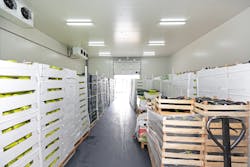Microgrids provide sustainable resilience for cold storage providers
The US food supply chain is complex. From indoor farming to food producers to the processors, cold storage facilities, distribution centers and, ultimately, retail grocery stores, there are a lot of moving parts that need to be evaluated holistically in order to guarantee the resiliency of the supply chain.
Extended power outages caused by extreme weather events, natural disasters or energy infrastructure issues can wreak havoc on the food supply chain. As an example, a cold storage facility housing frozen foods can go 12 to 24 hours without power before there are significant impacts on temperatures that could impact foods. Medium temperature operations with perishable foods only have up to a six hour window before food begins to spoil. If a hurricane shuts down one of these critical facilities, not only could the company’s financial losses be significant, but the impact of that disruption will likely ripple down the rest of the supply chain, ultimately impacting grocery stores, restaurants and convenience store customers.
For decades, cold storage facilities have done a good job of mitigating outage risks, either with reefer trucks, local backup generation, dry ice and other strategies. So how can the food supply chain, including cold storage facilities, ensure permanent, continuous power and do it in a more sustainable way to help with meeting carbon reduction goals? Many are turning to microgrids.
Microgrids provide resiliency
Microgrids sit in a sweet spot because they offer a sustainable and economic way to achieve energy resilience. A microgrid manages the use of both grid energy and on-site power generation sources such as solar, energy storage and ultra clean Tier 4 Final or natural gas generators.
Simply put, when the power goes out, the microgrid’s controller automatically disconnects from the grid and uses the on-site generation source to supply the facility with the electricity it needs to maintain continuity of business. When the grid power is restored, the microgrid controller reconnects to the grid. This process of “islanding” is how a microgrid provides resilience.
A microgrid also allows food supply chain facilities to leverage available utility demand response programs, turning it into a generating asset for the company. Each project needs to be evaluated to also leverage utility capacity, demand reduction, frequency regulation and RTP arbitrage, all of which can contribute to the economic case for a microgrid investment.
Microgrids reduce carbon emissions
But more than just a reliable source of backup power, a microgrid can reduce the carbon emissions of a cold storage facility. There is a strong commitment across the food supply chain to achieve specific sustainability and carbon reduction goals. The microgrid approach can accelerate their ability to achieve these goals. For example, those microgrids that use ultra clean Tier 4 Final or natural gas generators produce significantly lower emissions than previous models and allow facilities to participate in the utility demand response type programs. Those emissions are reduced even further by using sustainable fuels such as renewable diesel or renewable natural gas. The microgrid also acts as the central hub to allow for connection of current and future assets including EV charging infrastructure.
The bottom line
Energy resiliency is now a critical strategy in the food supply chain. Microgrids are part of our client discussions for both new and existing facilities to deliver critical resiliency, sustainability and economic justification. Ultimately microgrids ensure that the critical food supply chain can continuously serve its communities and clients.
Ken Hurd is senior vice president of grocery at PowerSecure.







